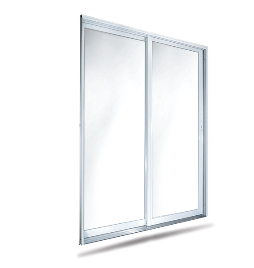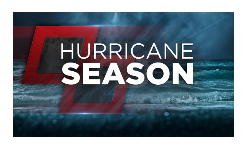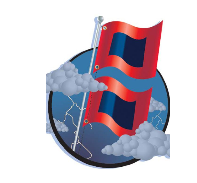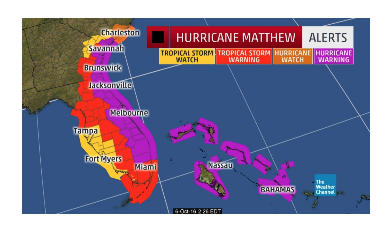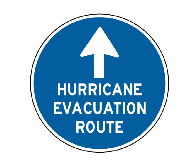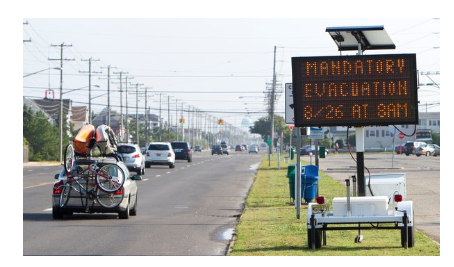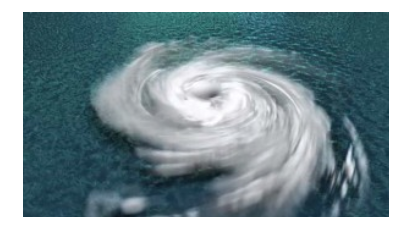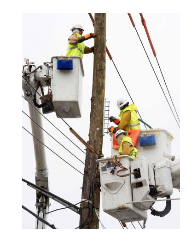Well Before Hurricane Season
√ If you plan to upgrade sliding glass doors with even more hurricane-resistant ones… or if you plan to purchase hurricane shutters, shop for them well before hurricane season. Both sliders and shutters must conform in every visible way — style, color and configuration — to the established look of the exterior Watermark, as outlined in the Watermark’s Architectural Standards. Get board approval before finalizing your order. To make sure the style you are considering conforms, take a color photo of the existing style to your dealer before making your purchase.
√ Update your Watermark insurance. Ask about your deductible. Ask about assessment reimbursement coverage should the Association have to specifically assess everyone because of hurricane damage. Ask about extra expense coverage for residents who have to vacate the premises due to hurricane damages.
√ Update photo/video inventory of your Watermark assets.
√ Create storage area for hurricane recovery supplies, such cleanup essentials as mops, shop-vacs, rags, buckets, bleach, work gloves, garbage bags.
June 1 to November 30.
√ It is your responsibility as owner to prepare your unit for hurricanes.
√ Before the arrival the most active part of Hurricane Season – right after Labor Day — take your balcony furniture indoors.
√ When a hurricane threatens, Watermark managers will have their hands full securing the pool area, office and grounds. They will also be available to assist owners needing a hand with such basic measures as getting balcony furniture moved indoors. If you need assistance with hurricane preparations, contact the office.
Hurricane Watch
Landfall less than 48 hours away
√ A Hurricane Watch is announcement that hurricane conditions are possible within a specified area — no need to panic, but consider it your wake-up call to take the current hurricane as a threat to you and to begin securing your property. All should now be paying attention to the path of the storm by staying up with advisories. Permanent residents should listen in particular for instructions from Volusia County emergency officials.
√ Watermark renters will be advised to vacate for their own safety and to allow owners time to secure their units.
√ Permanent residents should review their evacuation options in case a Hurricane Warning is issued… and start preparing a “Go-Pack” of items to take with them. Pack what you’ll need for at least several days away. In worse-case scenarios, it may be several weeks before you’ll return.
√ Owners with special needs should contact the office for assistance.
√ Provide the office with any temporary contact information
√ Top off your vehicle’s gas tank.
√ If you have completed your own hurricane plans, consider volunteering to assist the managers in securing the Watermark.
√ Although Category 1 hurricanes (74 mph to 95 mph winds) seldom warrant evacuations of well-constructed permanent structures such as the Watermark, you are strongly discouraged from remaining at the Watermark during any sized storm, if only because of the high probability of the electricity and elevator being down for extended periods during and after the storm.
Because of our barrier-island vulnerability to a storm surge, Volusia County emergency authorities strongly recommend everyone evacuate the beachside during any size hurricane. Along the immediate coast, storm surge is the greatest threat to life and property during a hurricane. Barrier islands are the most vulnerable areas to the storm surge.
√ For peace of mind, it is certainly prudent for elderly people, people living alone and others unfamiliar with hurricanes to voluntarily evacuate with the threat of even the smallest hurricane.
Hurricane Warning
Landfall less than 36 hours away
√ A Hurricane Warning is an announcement that hurricane conditions are expected within the specified area. It provides sufficient time to complete storm preparations, calmly collect your things, fill your vehicle’s gasoline tank and be prepared to move from the threatened area to a safer location if so directed by local officials.
It is foolhardy to try to ride out a storm greater than a Category 1 when you are in the area of predicted landfall. Volusia County authorities highly recommend that everyone on the beachside evacuate during any size hurricane, including a Category 1. Now is the time to secure your unit, and prepare to go to safer location.
√ Secure balcony and lower hurricane shutters. Lock slider doors. Protect sliding glass doors from wind-driven rain, at the very least by placing towels along the base of the interior track.
√ Pull out electrical plugs in areas where water intrusion may be a problem.
√ The choice to empty your refrigerator is yours. If you leave food in it and the power is out for days, you’ll return to a sickening fridge full of moldy food. However, if the power is out less than four hours, most food will remain edible.
√ To prevent water damage, move or elevate furnishings well away from the sliding glass doors; and roll back rugs.
√ Take front-door ornaments and doormat indoors.
√ Close curtains and blinds.
√ Notify office of your temporary contact information.
Voluntary Evacuation
No time for bravado now… Category 2 hurricanes, Category 3 or higher have caused death and destruction in their paths. On barrier islands such as ours, voluntary evacuations are often the tipoff that a mandatory evacuation order is only hours away. Those who can leave early, should leave early to avoid the nerve-racking traffic backups at the causeway bridges and on evacuation routes that often follow a mandatory evacuation order.
√ People who say they are going to stay put in their Watermark unit should plan for the loss of power and use of the elevator…and possibly the loss of water as well. During a bad hurricane, beachside holdouts cannot count on emergency responders to rescue them, as nearly all will be safely positioned on the mainland during the height of the storm, unable to cross causeway bridges until after the storm passes and bridges have reopened.
Mandatory evacuation
You should have completed all your preparedness measures by now, as there is precious little time to do anything more than confirm your evac destination, fill your gas tank (expect long lines at filling stations), shut off electricity, get in your car and leave for safer shelter.
√ Last-minute items you may need: more than a few day’s clothing, cash, meds & prescriptions, extra checkbooks, unpaid bills, the flash drive or other device that automatically backs up data stored on your computer, irreplaceable family pictures or treasures, artwork, collections.
During the storm
Presumably the Watermark would be completely vacant during a direct hit from a hurricane. But if you have remained, be sure the managers know. The safest place to stay during the height of storm is an interior room without windows.
√ Avoid using candles or gasoline-powered lanterns indoors.
√ If you have power, ensure cell phones are fully charged.
√ Use extreme care around electrical outlets.
√ Eat food that will spoil first.
√ When the hurricane eye passes over an area, there is a sudden calm, but it’s not over. Don’t venture out thinking the hurricane has passed. Follow hurricane movement closely on radio or TV to be sure that the danger is over.
Immediately after the storm
√ Don’t return to the Watermark until word goes out that it is safe to do so – that is, that the units and grounds are secure from hazards… that the causeway bridges are re-opened and access roads are free of downed power lines.
√ Waiting for the unit-by-unit damage assessment (a post-hurricane priority at the Watermark) will help give you some idea of the urgency for your getting back… and also of specific cleanup supplies you may need to bring.
√ When returning to the Watermark, plan to bring plenty of drinking water, food, ice, a cooler and cash with you. If the power is still out local stores and restaurants could be dark and credit card machines, gasoline pumps not working.
√ If power is on or there’s an emergency generator up and running, a Shop-Vac or Wet-Vac will expedite water removal. In any case, bring mops, rags, buckets, bleach, work gloves, garbage bags and other essential cleanup supplies with you, as they may be in short supply locally.
√ Before turning electricity back on, mop up standing water to avoid possible electric shock or electrocution.
√ Inspect your unit and assess damage, reporting anything potentially serious that was overlooked in the initial unit-by-unit inspection … most especially any leak or moisture that may require priority attention.
√ For insurance purposes photograph damage and debris before it is moved.
√ Do what is necessary — “drying-in” and “drying-out” — to mitigate your damages. Remove wet carpet to prevent the growth of mold. If the power has been off for a few days, mold may have already gotten the upper hand by the time you’re really able to start cleaning. Both the CDC and the EPA recommend bringing in a trained professional to clean up mold that covers more than 100 square feet or a 10-foot-by-10-foot area.
√ Professional restoration companies such as Servpro have sophisticated moisture extraction equipment to get this done. At the minimum, anyone you hire should have experience getting rid of mold, references you can call, and liability insurance.
√ Start hauling wet things, especially plush items like pillows, upholstered furniture, or curtains out to your garage where they can dry. Use a shop vac or wet vac to suck water out of soggy carpets.
√ You want to get as much air movement as possible over the wet areas. Fans can help, but they may not be enough. Consider renting or buying a dehumidifier to keep moisture levels low in the air in rooms you’re trying to dry.
√ Wet drywall loses structural integrity and it’s is often easier and less expensive to replace it after the source of the water is known and has been repaired. Time is of the essence because if the mold takes hold it will spread and become a bigger issue.
√ If you don’t have bottled water, you should boil water to make it safe. Boiling water will kill most types of disease-causing organisms. If you can’t boil water, you can disinfect it using household bleach. Bleach will kill some, but not all, types of disease-causing organisms that may be in the water. If the water is cloudy, filter it through clean cloths or allow it to settle, and draw off the clear water for disinfection. Add 1/8 teaspoon (or 8 drops) of regular, unscented, liquid household bleach for each gallon of water, stir it well and let it stand for 30 minutes before you use it. Store disinfected water in clean containers with covers.
√ Food tips: To be safe, remember, “When in doubt, throw it out.” Discard any food that has been at room temperature for two hours or more, and any food that has an unusual color or odor. Consume perishables first. Your refrigerator will keep foods cool for about four hours without power if it is unopened. Add block or dry ice to your refrigerator if the electricity will be off longer than four hours. Thawed food can usually be eaten if it is still “refrigerator cold,” or re-frozen if it still contains ice crystals.
√ Hurricane recovery typically means many hours of labor in the heat of summer. Do whatever is necessary to pace yourself. Avoid dehydration. Keep cool and keep your cool. Keep all receipts. Ask for help if you need it. Realize that others’ needs may be more urgent than yours. Pitch in and help others.
√ Condo boards have wider authority during a hurricane. During a state of emergency, they may:
• impose assessments, freely utilize reserve funds and make necessary repairs when a state of emergency has been declared to make sure their buildings and units are fit and safe for habitation, order a community-wide evacuation if the local authorities issue an evacuation order and provide the board with freedom from legal liability for any residents who ignore the order and stay.
• levy special assessments without a vote and to borrow money for emergency repairs.
• declare any portion of the property unavailable for entry or occupancy.
• contract for any services that are necessary to prevent further damage and necessary for health and safety.
• implement a disaster plan, which could include shutting off utilities.
• call board meetings with reasonable notice rather that normal notice requirements and to cancel and reschedule meetings.
name assistant directors to temporarily take the place of officers who are unavailable or incapacitated.

